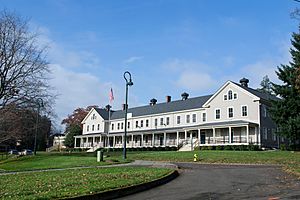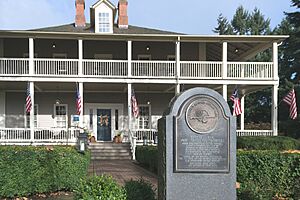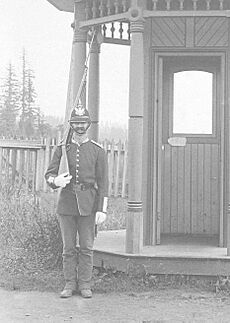Vancouver Barracks facts for kids
Quick facts for kids |
|
|
Fort Vancouver National Historic Site
|
|

Artillery barracks in the Fort Vancouver Historic Site area
|
|
| Lua error in Module:Location_map at line 420: attempt to index field 'wikibase' (a nil value). | |
| Location | Vancouver, Washington, U.S. |
|---|---|
| Built | 1849 |
| NRHP reference No. | 66000370 |
| Added to NRHP | October 15, 1966 |
The Vancouver Barracks was the very first United States Army base in the Pacific Northwest. It was built in 1849 in what is now Vancouver, Washington. The base was set up on a small hill, about 20 feet (6 meters) above the Fort Vancouver fur trading post. This trading post was run by the Hudson's Bay Company (HBC). The buildings of the barracks were built in a line near the Columbia River, about 2,000 yards (1,829 meters) from its bank.
Contents
Why Vancouver Barracks Was Built
In 1846, the Oregon Treaty was signed between Great Britain and the United States. This treaty settled a disagreement over the border in the Pacific Northwest. The two countries decided to split the land along the 49th parallel. This meant that Fort Vancouver became part of the U.S. However, the agreement allowed Great Britain's Hudson's Bay Company to keep operating its trading posts, including Fort Vancouver.
The Vancouver Barracks was created because of events like the Whitman massacre and the Cayuse War. The U.S. government wanted to have a military presence. This was to help manage the native peoples of the region. It also aimed to encourage more white European settlers to move to the Pacific Northwest. The U.S. Army chose to build its base right next to Fort Vancouver. This was because there were already settlers and important buildings there.
By October 1849, soldiers and supplies traveled across the country to reach Vancouver Barracks. Colonel William Wing Loring led this group of mounted soldiers. They brought 700 horses, 1,200 mules, and 171 supply wagons.
Conflicts with Native American Tribes
As disagreements between Native American tribes and American settlers grew, many conflicts broke out. These "Pacific Northwest Indian Wars" happened from about 1848 to 1879. Soldiers from Fort Vancouver were actively involved in these campaigns against Native American tribes. The Vancouver Barracks played a part in almost every military action against Native Americans in the Pacific Northwest.
Some of the major conflicts managed through Vancouver Barracks included the Cayuse War, Rogue River Wars, and Nez Perce War. These wars involved many different Native American groups. These included the Cayuse, Yakama, Spokane, and Nez Perce tribes.
During these conflicts, Vancouver Barracks served many purposes. It was a center for managing operations, a place for troops to stay, a training area, a supply storage, and a prison. Soldiers from Vancouver Barracks continued to help settlers even after this period of major conflicts.
Native American People Held at the Barracks
Since it was first built, the U.S. Army always had a prison or Guard House at Vancouver Barracks. Native American people were sometimes held there against their will as late as 1889. They were held as prisoners of war. Sometimes it was in preparation for moving them to reservations. Other times it was to protect white settlements. The U.S. Army also targeted important tribal leaders. They used the threat of being held captive against leaders who were organizing their people.
Because so many Native American people were held there, some historical records have even called the Fort a "reservation."
Vancouver Barracks in World Wars
The military base stayed active and was made larger for World War I. During this war, it was home to the Army's Spruce Production Division. This division was led by Colonel Brice Disque.
Between the two World Wars, the 5th Infantry Brigade was based there. From 1936 to 1938, a future Army Chief of Staff, George C. Marshall, was in charge of the post.
In World War II, Vancouver Barracks was used as a gathering place for soldiers before they left from the Seattle Port of Embarkation. At that time, the base covered 3,019 acres (12.22 square kilometers). It had enough space for 250 officers and 7,295 enlisted soldiers to live there.
After World War II, Vancouver Barracks became a smaller part of Fort Lewis. It kept a small number of active-duty soldiers.
Later, most of the living spaces were turned into military offices. The base became home to the 104th Division of the Army Reserve. It also housed units from the Washington National Guard.
Vancouver Barracks officially closed in 2011. This was part of a plan by the Base Realignment and Closure Commission. In 2012, during a Memorial Day ceremony, the south and east barracks were officially given to the National Park Service to care for.
Protecting History: Fort Vancouver National Historic Site
Because of its important role in United States history, the HBC Fort Vancouver was named a U.S. National Monument in 1948. It was later renamed Fort Vancouver National Historic Site in 1961. In 1996, an area of 366 acres (1.48 square kilometers) around the fort was created. This area included Kanaka Village, the Vancouver Barracks, and the riverbank. It is now called the Vancouver National Historic Reserve. The National Park Service takes care of it and offers tours of the fort.
Different Names Over Time
Throughout its time as a U.S. Army base, Vancouver Barracks had several different names. When it was first founded, it was called Camp Vancouver. In 1850, it was renamed Columbia Barracks. This name was used until 1853, when the base was called Fort Vancouver. This name lasted until 1879, when the name Vancouver Barracks was finally chosen and stuck.



